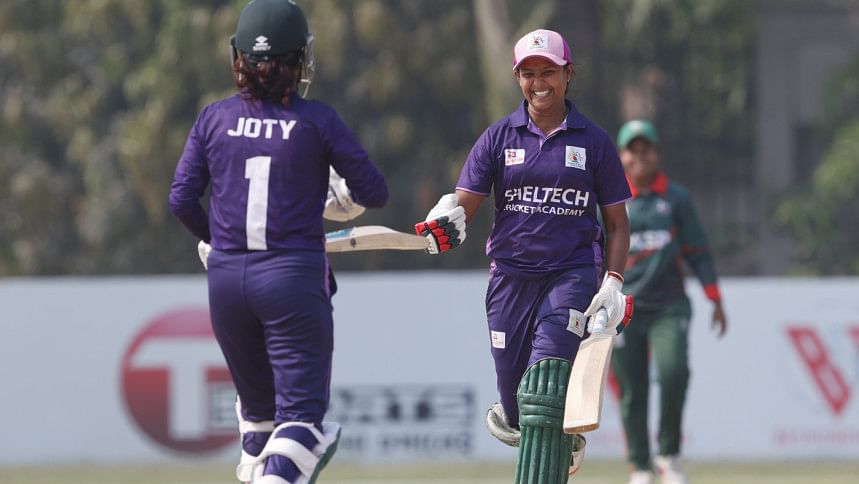A step towards improving batting intent

Beyond simply crowning a champion, any cricket tournament in Bangladesh must serve a greater purpose -- developing players for the national team. This year, the Women's Dhaka Premier League (DPL), held from February 19 to March 13, was also a crucial platform for preparing and selecting the squad for the Women's ODI World Cup qualifiers in Pakistan in April.
Bangladesh's past performances in global events highlighted a lack of aggression necessary to compete at the highest level. Addressing this required structural improvements in domestic cricket.
Two years ago, an official pointed out that most batters lacked the intent to attack. Teams would often play out 50 overs without prioritising getting to a high total. In the 2022 season, only three teams surpassed the 250-run mark, and there was just one instance of a 300-plus total across 29 games. In 2023-24, the figures improved slightly, with eight 250-plus scores in 43 matches, including two 400-plus totals by Abahani and a 300-plus score by Mohammedan. This season, across 36 games, there were seven 250-plus scores and four instances of teams reaching 300.
"We have seen that the national team rely heavily on one or two players, such as Nigar Sultana Joty. We are trying to ensure that more players contribute consistently. This league has identified several dependable performers, and individual strike rates have also improved. We've realised that scoring 180-200 runs on average is not enough, so emphasis was placed on increasing the scoring rate," said Nazmul Abedeen Fahim, head of the women's wing, in a recent BCB video.
The goal wasn't just to improve overall team scores but to enhance the depth of the national side. In that regard, several individuals stood out for their scoring rates this season. Shorna Akter, already in the national squad, scored 277 runs at a strike rate of 112.60 and an average of across six innings. Farzana Haque Pinky topped the charts with 507 runs, while players like Sharmin Supta, Sarmin Sultana, Ishma Tanjim, and Joty maintained strike rates close to or above 80.
Among players from outside the national team pool, U-19 captain Sumaiya Akter amassed 267 runs at a strike rate above 80, averaging over 53. The Sheltech Cricket Academy cricketer played one of the tournament's standout innings -- an 83 off 101 balls against Mohammedan in the opener.
"We need to prioritise matches between the more competitive teams to identify the best performers. Sumaiya played an extraordinary innings. Strike rate has been a longstanding issue, but instilling intent takes time. However, I have noticed improvements from individuals," noted a team official of one of the clubs.
Other notable performers included Farzana Yeasmin, a pace-bowling all-rounder who was named the tournament's emerging star, and Sadia Akter from BKSP, both of whom impressed with their batting. Jannatul Ferdous took 21 wickets and earned a spot in the World Cup qualifiers squad, while pacer Fariha Trishna bagged 16 wickets at an average of 10 with an economy of 2.96. Fuara Begum played a key role in Sheltech's championship run, taking seven wickets at an economy of 2.40.
"I feel the standard has improved compared to last year. The top four or five teams were strong, while some were average, but overall, the level was better. We have moved away from a conservative approach in the Powerplay and are focusing on maximising the first 10 overs to ease the pressure on later batters. Players have absorbed this mindset and attempted to execute game plan-- something they did not do in international matches," national women's team selector Sajjad Ahmed Shipon told The Daily Star.
Sajjad further emphasised the need to enhance the first division to match the premier league's level while continuing to develop U-19 and school-level cricket.
Some clubs have also improved payment structures, with sources indicating that Abahani, Sheltech, and Mohammedan offered better financial support this season. However, issues with pitch quality and ball standards remain. The CA ball used this season tended to move unpredictably, making stroke play challenging. Meanwhile, it goes without saying that better wickets would encourage more aggressive batting.
While there is still a long way to go for WDPL to match international standards, the BCB hopes that an expanded and improved player pool coming from the competition will be able to shape the national team's future.

 For all latest news, follow The Daily Star's Google News channel.
For all latest news, follow The Daily Star's Google News channel. 



Comments